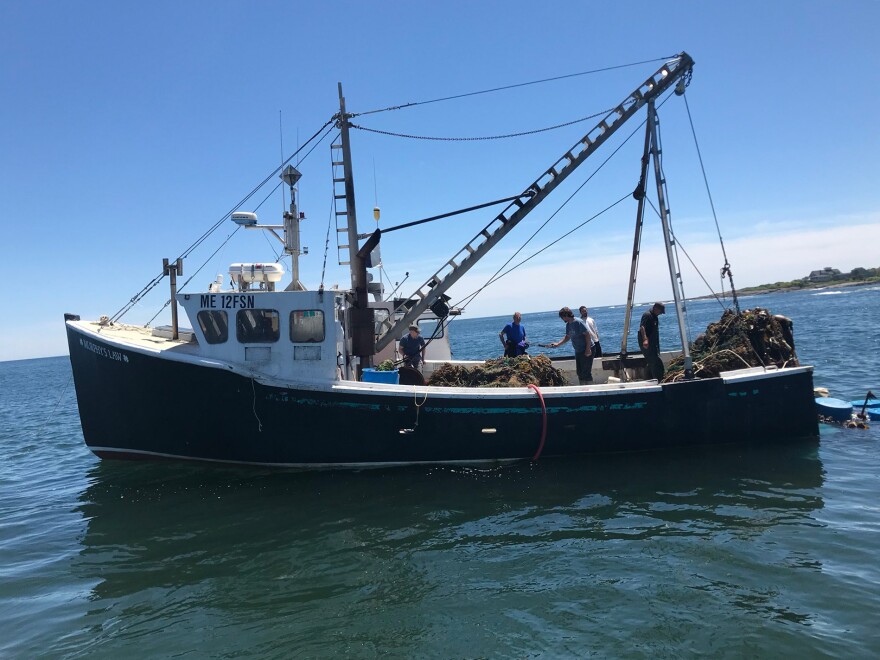Every year, fishermen lose tons of gear along the coast of Maine. It can collect into jumbled masses, what’s known as “ghost gear,” that can be hazardous to navigation and marine life. On Friday, a group of divers, fishermen and scientists hauled up a giant ball that’s been forming off Cape Elizabeth for years.
Motoring his fishing boat, the Wild Irish Rose, out of Portland Harbor, Long Island fisherman Steve Train says no one wants to lose gear, but it happens. A half hour later, he and two other boats converge off Cape Elizabeth Friday morning, near Two Lights State Park.
From the Murphy’s Law, salvage diver Paul Fischer starts the day’s effort in a dry suit, swimming down below a collection of lobster buoys that mark a mass of ghost gear below that’s been growing for years.
“It’s just a mass of — like a spider web of crap,” he says.
On his first return to the boat, Fischer describes what they found. An intertwined jumble of lobster traps and buoys, rope, fishing nets and line, hoses, styrofoam and more.
“I mean everything gets dragged into this thing. Once it starts it just keeps growing and growing all the time. Until you remove it,” he says.
Under the surface, Fischer’s partner, Jim Buxton, attaches 50-gallon plastic drums to the gear and fills them with air to float the mass to the surface. The men, including Long Island fisherman Steve Train, haul it toward the boat.
Buxton attaches a hook from a 20-foot-tall winch to the still-submerged gear. Slowly, the misshapen conglomerate made mostly of rope and net, plus busted lobster traps, buoys and seaweed is reared over the boat’s transom. It has a weirdly animal look, with a ropy head and neck and a long tail into the sea.

The men successfully hack some off. The winch strains at the rest, and the rope breaks with a loud snap. Men scatter as the bulk of the ghost gear drops back underwater.
Buxton suits back up to dive again, and reattach the floats.
In the lull, Erin Pelletier, executive director of the Gulf of Maine Lobster Foundation, says the project is a partnership between her group, the Ocean Conservancy, and local fishermen.
An estimated 640,000 tons of gear are lost in the world’s oceans each year, including some 175,000 lobster traps in the Gulf of Maine. Pelletier says this day’s work could cost as much as $15,000, which she adds is well worth it.
“This right here is prime fishing ground, but they haven’t been able to use this area because of all the entanglement issues that they’re going to get. If they set a trap near this and the currents come through and their traps roll into it and their gear is lost. You see all those buoys right here that are coming up with it, those are all fishing gear that’s been caught up in it,” she says.
“We also know that balls like this in storms, if they are pushed around or carried over the bottom, can damage the substrate,” says Nicholas Mallos, who directs the Ocean Conservancy’s international Trash-Free Seas program. “That also in turn can destroy habitat that would otherwise be used by lobsters or crabs or commercially viable seafood. So it’s not only the environmental impact that things like this have to the environment and the ocean, but also the economic impact it has directly to the fishers but also to the coastal economies.”
The crew successfully brings more of the tangle on board. They estimate that it weighs at least 10,000 pounds. And as they continue to work it up, piece by piece.

The winch’s A-frame starts to buckle, but this time the crew takes off the tension just in time. So the crew gives up on trying to haul the mass on board, instead towing it into Portland Harbor.
They’ll need a bigger winch to haul it up on shore, so the laborious task of cutting up a 4-ton snarl of rope, metal, seaweed and plastic and carting it to a waste incinerator is postponed till Monday.


